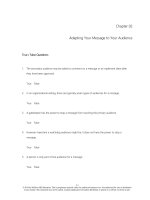Business communication building critical skill 3rd by locker module 25
Bạn đang xem bản rút gọn của tài liệu. Xem và tải ngay bản đầy đủ của tài liệu tại đây (719.15 KB, 9 trang )
PPT
PPT
Module
Module 25
25
Using
UsingVisuals
Visuals
McGraw-Hill/Irwin
©2007, The McGraw-Hill Companies, All Rights
25-2
Using
Using Visuals
Visuals
♦To learn how to
Use visuals to tell stories.
Match the visual to the story.
Design visuals.
Make visuals ethical.
Use visuals in your document or
presentation.
25-3
Using
Using Visuals
Visuals
Start by answering these questions:
What are stories, and how do I find them?
Does it matter what kind of visual I use?
What design conventions should I follow?
Can I use color and clip art?
What else do I need to check for?
Can I use the same visuals in my
document and my presentation?
25-4
Use
Use Visuals
Visuals
♦In the rough draft to
See that ideas are presented completely.
Find relationships.
♦In the final draft to
Make points vivid.
Emphasize material.
Present material more compactly and with
less repetition.
25-5
Good
Good Stories
Stories
♦ May
Support a hunch you
have.
Surprise you or challenge
so-called “common
knowledge.”
Show trends or changes.
Have commercial or social
significance.
Provide information
needed for action.
Be personally relevant to
you and the audience.
25-6
Types
Types of
of Visuals
Visuals
♦Tables
♦Pie Chart
♦Bar Chart
♦Line Graph
25-7
Components
Components of
of Visuals
Visuals
♦A title that tells the visual’s story.
♦A clear indication of what the data
are.
♦Clearly labeled units.
♦Labels or legends.
♦The data’s source, if it’s reproduced.
♦The visual’s source, if it’s
reproduced.
25-8
Visual
Visual Caveats
Caveats
♦Color
Be aware of cultural meanings.
Use no more than five when colors have
meanings.
♦Clip Art
Avoid bias; check clip art for balance (e.g.,
age, race, ethnicity, or gender).
♦Chartjunk
Avoid art that distorts data or sends
incorrect messages.
25-9
Chartjunk
Chartjunk
♦Example
Avoid
perspective
graphs—such
as this one—
which distort
data and are
hard to read.









